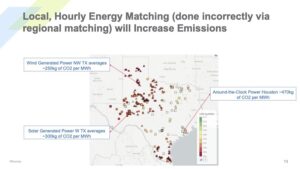
After last week’s startup roundup, we’ll turn our attention to what the bigger companies have been up to in the first quarter.
Regenerative agriculture has once again dominated the corporate food agenda. In addition, decarbonization commitments and requirements have continued to advance alternative proteins — particularly in Europe. And in the United States, health has popped up as an emerging issue for companies in response to a White House push and consumer interests. Let’s unpack the details.
Growing depth and breadth of regenerative agriculture
Regenerative agriculture has been popular for a while. Watching company after company publish commitments over the past years, you could think that all the regenerative strategies must be out by now. But that’s not the case. I ended up with another long list of new announcements this quarter. It includes expanded work from established regenerative players such as PepsiCo and Danone and initiatives from newer names such as Carlsberg and Beam Suntory.
PepsiCo made the by-far biggest splash this quarter. The food giant announced a $216 million investment into three organizations — Practical Farmers of Iowa, Soil and Water Outcomes Fund and Illinois Corn Growers Association. They plan to work with farmers in PepsiCo’s supply chain to adopt practices with soil, carbon, water, biodiversity and economic benefits.
Two other announcements expanding existing regenerative agriculture commitments also stood out. Danone pledged to reduce methane emissions from its milk supply chain by 30 percent by 2030. Nestlé and Cargill partnered with the National Fish and Wildlife Foundation (NFWF) to jointly invest $15 million to bring soil health practices to 1.7 million acres of cattle rangelands across the country.
Beyond the commitments, regenerative practices are reaching new geographies and commodities. In Europe, Carlsberg announced expanding its regenerative barley sourcing. And Mondelez is graduating a wheat pilot that tested diversified crop rotations, fertilizer optimization and other practices to a longer-term program. Over in Mexico, Beam Suntory is recruiting agave growers into the regenerative club.
Despite the ever-growing industry interest, unified regenerative agriculture definitions and implementation standards are still absent — putting these companies’ work at risk of greenwashing, as a Food and Land Use Coalition report warned at the beginning of the quarter. And that doesn’t seem to be changing anytime soon since regenerative agriculture’s openness has been a key feature of its adoption at scale.
Plant-based food commitments are maturing
Companies are pressured to make good on their net-zero commitments, and 2025 or 2030 goals are approaching quickly. In food and agriculture, switching meat, dairy and eggs for plant-based proteins is one of the most straightforward ways to make good on those promises. While promoting plant-based foods has long been avoided due to their unpopularity with consumers, more large companies are including them in their climate toolbox.
Ikea is one of them. The furniture company — which also doubles as a major foodservice provider with 520 million eaters just last year — announced plans to transition its cafeteria menus to be 50 percent plant-based and its packaged meals to be 80 percent by 2025.
Aldi and Lidl — Europe’s largest discount supermarket chains headquartered in Germany and expanding in the U.S. — have also made plant-based strides. Aldi announced the expansion of its vegan product range from 700 to over 1,000 products by the end of 2024. Meanwhile, Lidl also pledged to increase its vegan offerings, stating there was “no alternative” to this step if we want to live within the world’s planetary boundaries. Lidl has yet to conduct an analysis that will inform more concrete goals.
Despite the growing industry interest, unified regenerative agriculture definitions and implementation standards are still absent — putting the companies’ work at risk of greenwashing.
These are rather radical statements from supermarkets catering to lower-income consumers who tend to be less environmentally conscious. The good news is they would make sustainable eating accessible to more people.
In addition to these bigger-picture strategies, the quarter offered a plethora of new vegan product announcements and other initiatives — mainly across Europe.
McDonald’s partnered with Oatly in Austria, brought a double McPlant to the United Kingdom and Ireland and launched a plant-based burger and nuggets in Germany (where it harvested lots of criticism for only making the protein vegan, rather than all the ingredients and preparing them alongside their animal-based counterparts). Heinz UK came to market with vegan versions of two of its most popular canned products (creamy tomato soup and beans with sausages). Hershey released plant-based peanut butter cups. Lastly, two new plant-based innovation centers were announced in the Netherlands.
Public-private partnerships for health and nutrition
The White House elevated hunger, nutrition and health on the corporate agenda with last year’s conference focusing on these topics and the launch of related initiatives. Back in September, Bowery, Chobani, Doordash and Google participated in partnerships to improve food access and affordability.
At the end of Q1, the Biden administration launched an additional challenge supported by Doordash and Instacart, among other organizations. By participating, the online shopping platforms committed to promoting and highlighting more healthy foods, such as fresh produce, on their sites.
The hope is that the White House initiatives will have cascading effects bolstered by market signals pointing in the same direction. It’s been long overdue for food companies to pay better attention to the nutritional quality of the products they manufacture and sell. For example, Nestlé — one of the world’s largest food companies — recently stated that only 37 percent of its net sales come from healthy products. In comparison, 43 percent come from products with poor nutritional quality.
In February, ADM invested $30 million in a new Spanish facility to manufacture probiotics and postbiotics in response to the growing global demand for health and well-being products. Many other food multinationals are leaning into air-fried products or foods that can be prepared in air fryers to appeal to health-conscious consumers.
The crux of this matter is that healthy products are less prone to offering attractive profit margins. So even if the consumer and policy trends turn out to last, food companies will likely continue to have adverse financial incentives to promote unhealthy foods. Products with high margins and addictive features (read: high in salt, fat and carbs) tend to be found in the snack aisle rather than the produce section.
- SEO Powered Content & PR Distribution. Get Amplified Today.
- Platoblockchain. Web3 Metaverse Intelligence. Knowledge Amplified. Access Here.
- Source: https://www.greenbiz.com/article/global-food-giants-grow-regenerative-agriculture-alternative-protein
- :is
- $UP
- 000
- 1
- 2024
- 7
- a
- absent
- access
- accessible
- across
- addition
- Additional
- administration
- adopt
- Adoption
- advance
- adverse
- After
- agenda
- agriculture
- AIR
- All
- alongside
- alternative
- among
- analysis
- and
- announced
- Announcements
- Another
- appeal
- appeared
- approaching
- ARE
- article
- AS
- Association
- At
- attention
- attractive
- Austria
- avoided
- back
- BE
- Beam
- Beginning
- benefits
- Better
- biden
- Biden Administration
- bigger
- Biggest
- boundaries
- breadth
- bring
- brought
- burger
- by
- CAN
- carbon
- Cargill
- case
- Centers
- chain
- chains
- changing
- Climate
- club
- CNBC
- COM
- come
- committed
- Commodities
- Companies
- company
- comparison
- Conduct
- conscious
- consumer
- Consumers
- continue
- continued
- Corporate
- could
- country
- criticism
- crop
- dairy
- decarbonization
- Demand
- depth
- details
- direction
- Discount
- diversified
- Doesn’t
- DoorDash
- Economic
- effects
- Eggs
- elevated
- emerging
- Emissions
- environmentally
- established
- Europe
- Europes
- Even
- ever-growing
- Every
- example
- existing
- expanded
- expanding
- expansion
- Facility
- farmers
- Fat
- Features
- February
- financial
- First
- Fish
- focusing
- food
- Food and Agriculture
- foods
- For
- found
- Foundation
- fresh
- from
- fund
- geographies
- Germany
- get
- giant
- Global
- Goals
- good
- Grow
- growers
- Growing
- Have
- headquartered
- Health
- healthy
- High
- highlighting
- hope
- House
- HTML
- HTTPS
- hunger
- i
- illinois
- implementation
- improve
- in
- Incentives
- includes
- Including
- industry
- inform
- initiatives
- Innovation
- interest
- interests
- Invest
- invested
- investment
- Iowa
- ireland
- issue
- IT
- ITS
- jpg
- Kingdom
- Land
- large
- largest
- Last
- Last Year
- launch
- launched
- likely
- List
- live
- Long
- made
- major
- make
- Making
- many
- margins
- Market
- Matter
- meals
- Meanwhile
- Meat
- methane
- methane emissions
- Mexico
- Milk
- million
- more
- most
- Most Popular
- names
- National
- net
- net-zero
- Netherlands
- New
- news
- node
- nutrition
- of
- offered
- offering
- on
- ONE
- online
- online shopping
- Openness
- optimization
- organizations
- originally
- Other
- part
- participated
- participating
- particularly
- partnered
- partnerships
- past
- Pay
- People
- percent
- plan
- Platforms
- plato
- Plato Data Intelligence
- PlatoData
- players
- plethora
- policy
- poor
- Popular
- Practical
- practices
- prepared
- preparing
- produce
- Product
- Products
- Profit
- Program
- promises
- promote
- promoting
- Protein
- Proteins
- provider
- publish
- Push
- Putting
- Q1
- quality
- Quarter
- quickly
- radical
- range
- rather
- reaching
- Read
- recruiting
- reduce
- regenerative
- Regenerative Agriculture
- related
- report
- Requirements
- response
- Reuters
- Risk
- s
- sales
- salt
- same
- Scale
- Section
- sell
- September
- Shopping
- signals
- since
- Sites
- So
- Soon
- Sourcing
- Spanish
- standards
- statements
- States
- Step
- Still
- straightforward
- strategies
- subscribe
- such
- supply
- supply chain
- Supported
- Sustainability
- sustainable
- that
- The
- the Netherlands
- the United Kingdom
- their
- Them
- These
- three
- to
- Toolbox
- Topics
- transition
- Trends
- TURN
- u.s.
- Uk
- unified
- United
- United Kingdom
- United States
- use
- watching
- Water
- ways
- What
- which
- while
- white
- White House
- WHO
- Wildlife
- will
- with
- within
- Work
- world’s
- would
- year
- years
- Your
- zephyrnet








